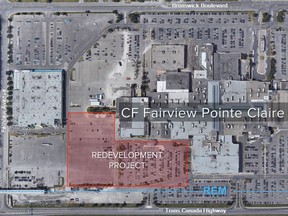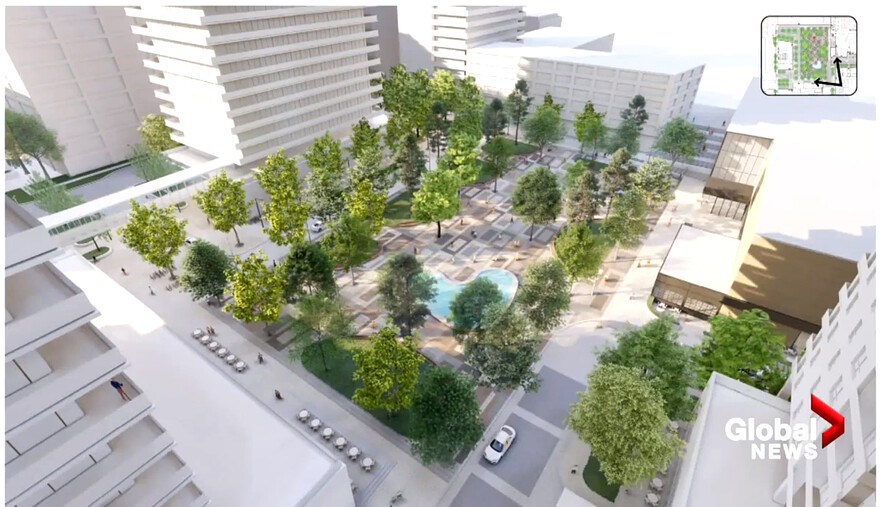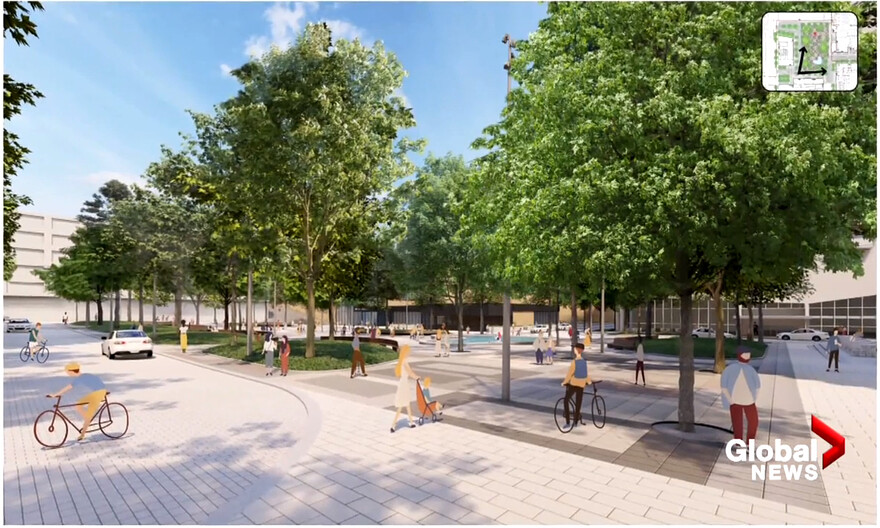Cadillac Fairview unveils shopping centre project near future REM
Cadillac Fairview says project would eliminate a major heat island by replacing some 900 asphalt parking spaces at Fairview shopping centre
John Meagher • Montreal Gazette
Feb 24, 2022 • 3 hours ago • 2 minute read

Cadillac Fairview’s redevelopment project aims to transform the southwest portion of the Fairview Pointe-Claire shopping centre parking lot. Cadillac Fairview
Cadillac Fairview presented its long-awaited redevelopment plan Wednesday for the Fairview shopping centre parking lot in Pointe-Claire, despite a recent city-imposed building freeze for the area.
Brian Salpeter, senior vice-president of development at Cadillac Fairview, said this particular redevelopment plan pertains to the southwest portion of the shopping centre parking lot.
The project would include a building with 435 residential units for seniors, connected to the shopping centre by an indoor bridge. It would also have two residential buildings with more than 400 rental units. A public square, or plaza, would be open to all and form the heart of the development. Wide sidewalks for pedestrians and bike paths are also planned. Underground and garage parking will be available to motorists.
Salpeter called the project a “human-centric mixed-use residential development, focused on active transportation, walking and cycling … directly connected to our shopping centre and located close to the future Fairview Pointe-Claire REM station and new bus terminal.”
He said the project would eliminate a major heat island by replacing approximately 900 asphalt parking spaces, and also meets the residential needs of first-time buyers, young families and downsizing empty-nesters.
Although the city of Pointe-Claire said it has yet to receive a formal development application from Cadillac Fairview, Salpeter said the project has been the “subject of in depth discussions with the city of Pointe-Claire for the past few years.”
“And not only does it comply with Pointe-Claire’s special planning program that was established four years ago, as well as the current zoning bylaws, it was designed to give effect to the city’s own PPU (urban plan).”
Therefore, he said, there should “no controversy with respect to this project which has been underway for years.”
Salpeter said the project’s architectural plans were submitted to the city in July of 2021. “It had been the subject of proactive and regular discussions with the urban planning department … before and since then.”
Pointe-Claire Mayor Tim Thomas recently told the Montreal Gazette the city has not received a formal application from CF for its downtown satellite project.
“There have been no plans submitted in writing,” he said.
Thomas also noted the building freeze applies only to multi-level residential developments, not the shopping centre. “The RCI has no limitations on their commercial expansion.”
“Where we have concerns is multi-level residential, which is currently under scrutiny by the population of Pointe-Claire to decide how much and what levels we want (to allow).”
At the outset of Wednesday’s technical briefing, Salpeter stressed that this phase of the redevelopment project does not involve any of the lands west of the shopping centre, which he referred to as the “John Abbott lands.”
Cadillac Fairview acquired the land, which includes the Fairview Forest, in 2013 from Smart Centres. At one time, John Abbott College had owned the property.
Salpeter said the site has “attracted a lot of interest and attention for the last year.”
“Regarding the future development of the John Abbott lands, we do wish to engage in meaningful dialogue with the city and the entire community to further elaborate the best way to develop this site. This, however, will be a topic for another day.”
Reportage vidéo sur le site de Global News

